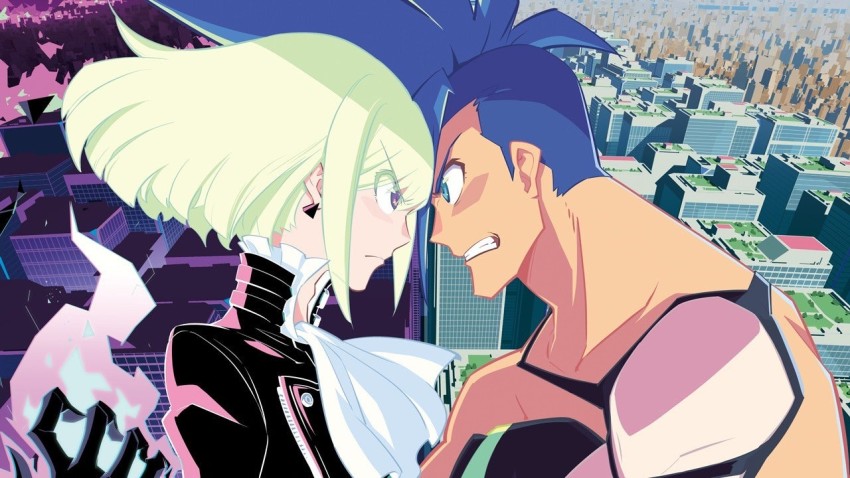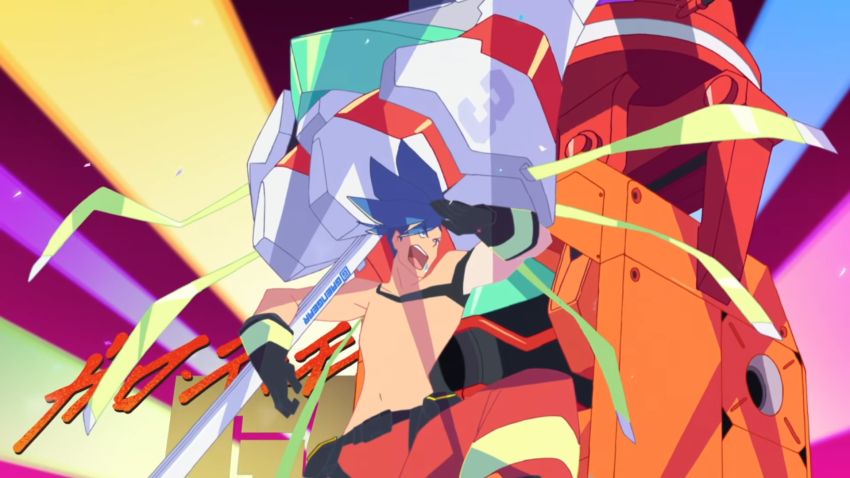Interview: Studio Trigger
November 21, 2019 · 0 comments
By Andrew Osmond.
 Studio Trigger’s romping spectacle Promare had its British premiere at the Scotland Loves Anime Film Festival, and three of the film’s key staff were on hand to present it. Hiroyuki Imaishi is Promare’s director; he’s been a hero to fandom since he helmed Gainax’s mecha series Gurren Lagann back in 2007, before going on to direct Panty & Stocking and Kill la Kill. The latter was made by the new studio Trigger, with which Imaishi has been identified ever since.
Studio Trigger’s romping spectacle Promare had its British premiere at the Scotland Loves Anime Film Festival, and three of the film’s key staff were on hand to present it. Hiroyuki Imaishi is Promare’s director; he’s been a hero to fandom since he helmed Gainax’s mecha series Gurren Lagann back in 2007, before going on to direct Panty & Stocking and Kill la Kill. The latter was made by the new studio Trigger, with which Imaishi has been identified ever since.
Accompanying him to Scotland was Hiromi Wakabayashi, who’s supported Imaishi’s anime since the days of Gurren Lagann (he had the initial idea for Panty & Stocking) and is now the Creative Producer on Promare. As for designer Shigeto Koyama, he was involved with Kill la Kill’s “kamui” uniforms and the mecha in Gurren Lagann, Promare and DARLING in the FRANXX, to say nothing of his designing Baymax for Disney’s film Big Hero 6.
Gurren Lagann and Kill la Kill were both spectacular anime. In visual terms, what were the main ways that you wanted Promare to go beyond what those previous anime had achieved?
Wakabayashi – Kill la Kill was in classic dramatic manga style. With Promare we wanted to do something a little different, more of a “cartoon.”
The anime by Studio Trigger and Imaishi feature many crazy transformations and wild movements that feel completely spontaneous. Promare uses a lot of CG anime, and some fans may worry that CG might lose the human spontaneity of your previous work.
 Imaishi – About half of Promare is hand-drawn, and the action scenes use 3D; they complement each other. I got more involved in the 3D part, and actually did hand-drawing on top of it, and edited what was made. The 3D was created digitally, but the designs and drawings were still done by hand. Anything that needed to be done by hand was done by hand: designs, key animation.
Imaishi – About half of Promare is hand-drawn, and the action scenes use 3D; they complement each other. I got more involved in the 3D part, and actually did hand-drawing on top of it, and edited what was made. The 3D was created digitally, but the designs and drawings were still done by hand. Anything that needed to be done by hand was done by hand: designs, key animation.
Did you have any trouble mixing CG anime with more traditional animation methods in the film?
Imaishi – We expected it was going to be difficult, so we tried to balance the sides out before we started, at the design and storyboard stage. We tried not to mix both techniques at the same time, and also we were aware that we needed to make something that could be done by either technique. Some things we worked on originally in 3D had to be changed and done in hand-drawing, and we have hybrids of both techniques. When we mixed both, we just needed manpower, more people to work on it.
(For Mr Koyama) What kind of look were you aiming for with the mecha in Promare?
Koyama – I had to design considering that it was going to be in CG, but the organic shapes were the difficult part, because the shadows tend to be really complicated by the lighting. I was aware we needed to use many geometric shapes, like box shapes, so that the shadows could be cast on flat surfaces.
The action finale of Promare packs in a huge amount of jokes and ideas. Was more material added to the climax as you were making the film?
Wakabayashi – Yes, we were all adding our ideas.
(For Imaishi) Your work has always been associated with fast, crazy, funny animation. Did you always have this sense of humour from your childhood, and were there particular media that made you love this kind of visual humour?
Imaishi – I always liked action, robot animation; they’re not slow or atmospheric. Or kids fighting; I liked that sort of thing since I was a child. Gundam, Dokonjo Gaeru… [The latter is a children’s comedy series about a boy who communicates with the frog on his T-shirt, from a 1970s Shonen Jump strip.]
 You have used “extreme” humour in some of your anime, often involving jokes about sex and other bodily functions. Do you just find them funny, or are there more particular reasons why you like to put these jokes in your anime?
You have used “extreme” humour in some of your anime, often involving jokes about sex and other bodily functions. Do you just find them funny, or are there more particular reasons why you like to put these jokes in your anime?
Imaishi – That was my rebellious feeling towards everything. When I started out, all this naughty stuff was torn down, anime was quite gentrified. But I think the anime I used to watch when I was a child were more sexy. Actually, I didn’t make anything sex-related when I was making my own indie things; I started doing it once I was in [the industry] because everything was torn down and I just wanted to do something different.
You did a lot of work on the series FLCL and then you made your director debut on Dead Leaves. Was this a happy and exciting time for you?
Imaishi – Everything was fun when I was younger. I wanted to do everything that I could. But obviously “fun” isn’t always good as work; I learned things over the years, putting on different aspects; I always want to improve my work.
Gurren Lagann was massively popular with foreign fans. How did audiences respond in Japan? I believe it was shown at not such a late time on Japanese TV, so I wondered if there were elementary school students who enjoyed it.
[Imaishi’s and Wakabayashi’s answers to this question overlap. Imaishi thinks Gurren Lagann’s Japanese audience was largely existing anime fans. However, Wakabayashi says that TV Tokyo did broadcast the series in the morning, so that some children and parents would have seen it; therefore Wakabayashi thinks it had more of a family audience than Kill la Kill had.]You all worked at other studios before the founding of Studio Trigger; for example, Gurren Lagann was made at Gainax. What were the main reasons for Trigger being founded? Was it a feeling that you would never have the level of creative freedom at other studios to be able to do your best work?
Wakabayashi – Actually Gainax was quite liberal [in terms of creative freedom] in the anime industry. Only Gainax would have done Panty & Stocking with Garterbelt, any other studio wouldn’t have done it. But the bosses at Gainax, the generation who had made The Wings of Honneamise, what they wanted to do was different from what we wanted to do. So rather than being safe, making what would make everybody happy, we thought we might want to do what we wanted, and be responsible for what we make. It was like a natural progression.
 Studio Trigger has released many anime since its founding, often with different directors. Sometimes they have a little more drama and less comedy, like the series Kiznaiver. However, do you think there is a “Studio Trigger anime” style that runs through all the studio’s work – for example, a sense of humour or brashness that always makes it different from other studios?
Studio Trigger has released many anime since its founding, often with different directors. Sometimes they have a little more drama and less comedy, like the series Kiznaiver. However, do you think there is a “Studio Trigger anime” style that runs through all the studio’s work – for example, a sense of humour or brashness that always makes it different from other studios?
Wakabayashi – We don’t really think of genre or style as such. We just want to do what the directors or staff want to make, what they find funny or interesting or exciting. As a result, there might be “our” style, but it’s not something we’re actually aware of.
The mecha series DARLING in the FRANXX was a co-production between the Trigger studio and a different anime studio, A-1 Pictures. Do you think it was a successful collaboration, and is the studio planning to do similar collaborations in the future?
Imaishi – I don’t know if it was a success or not, but it was an experiment; it was more like a condition we had to follow. We had worked with FRANXX’s director Atsushi Nishigori before and we wanted to work with him again. [Nishigori had had numerous credits on Gurren Lagann and Panty & Stocking.]
Wakabayashi – It wasn’t set in stone in the beginning. He wanted to make this anime and needed help, and we were the only people who could help. He had this science-fiction anime in mind and who could work on it – people who had made Gurren Lagann and Panty & Stocking, so he sought advice from us. We decided to work together; we were more like a brain for that project. We planned, developed characters, alien design, Trigger did all of that. The story, the actual anime, was done by A-1 Pictures. The reason was that Nishigori’s first animation was produced by A-1 Pictures [probably referring to The Idolm@ster, a 2011 series which seems to have been Nishigori’s debut as director]. So we actually had to work with them.
Trigger’s series include Little Witch Academia, which is very funny but also much more suitable for family viewing than some of Trigger’s other work. Will Trigger make more family-oriented series in the future?
Wakabayashi – Promare as well (everyone laughs). The target audience for Promare is from newborns to ashes.
I wanted to finish by asking a particularly British-centric question. There is a popular British comic full of rude humour called Viz (not connected with the American publishing company). I wondered if any of you had heard of it?
Wakabayashi – No, not at all. Shall we google it?
Promare is released in the UK by Anime Limited.
Leave a Reply